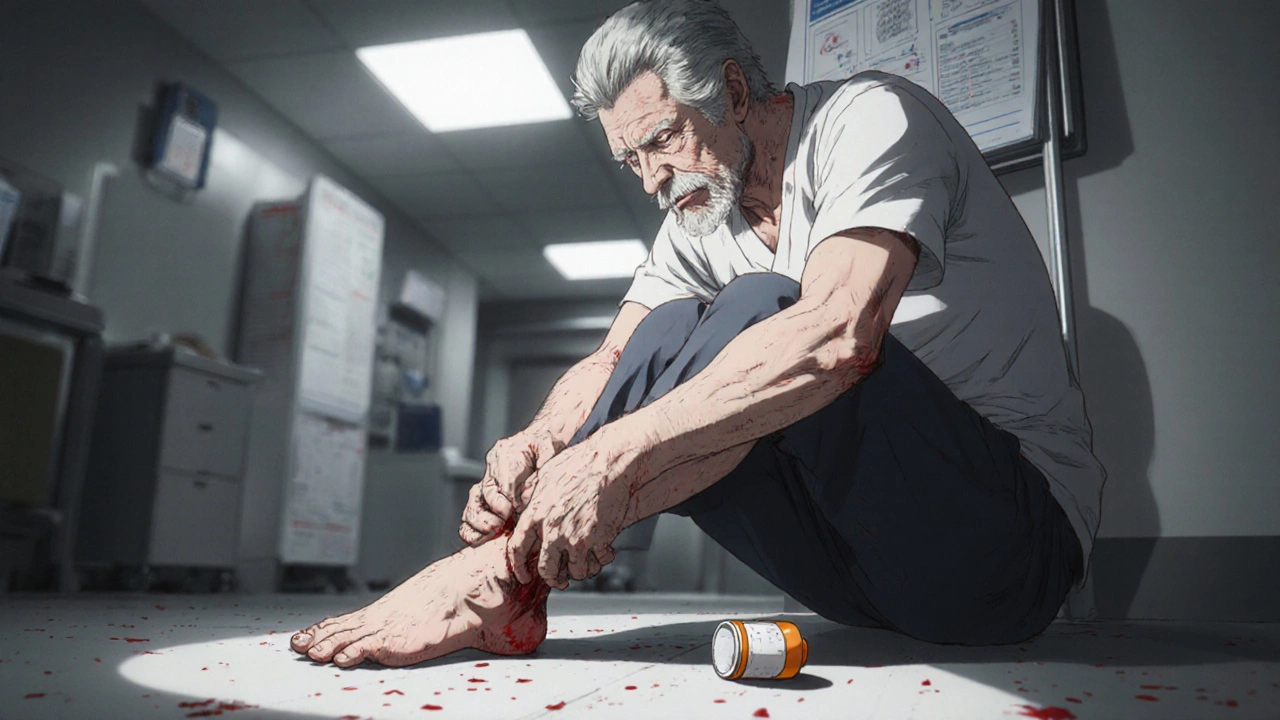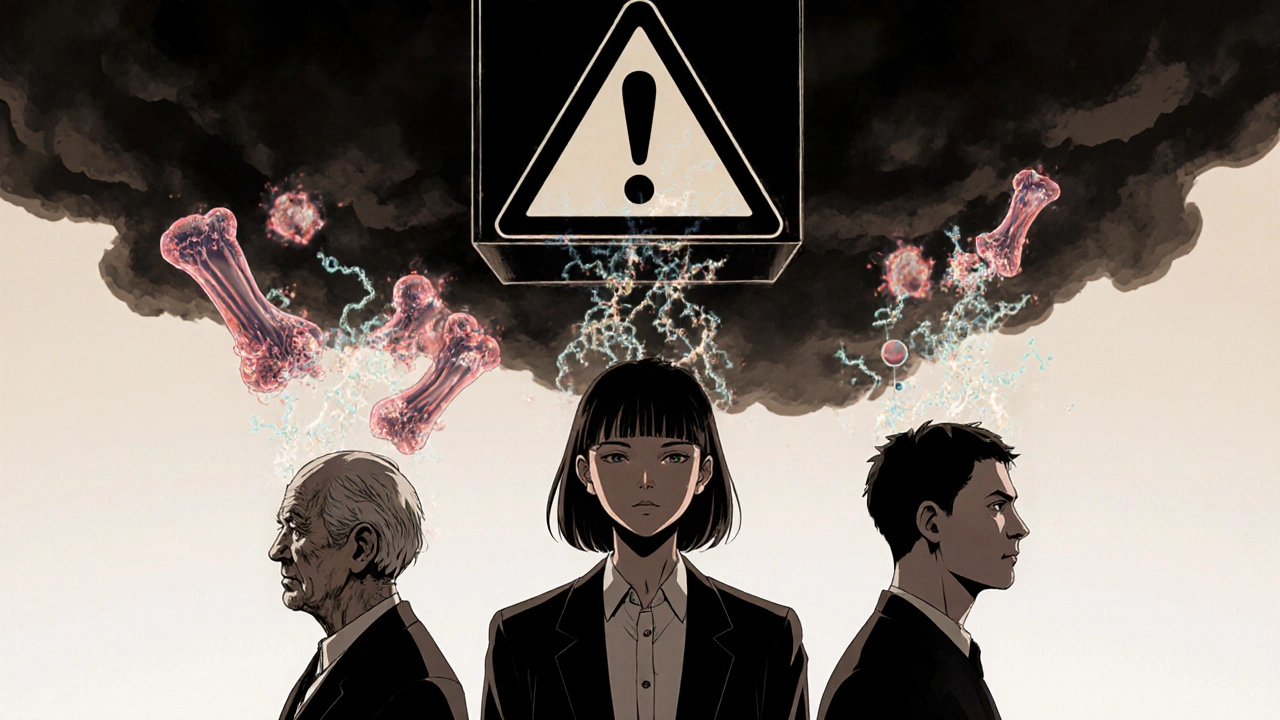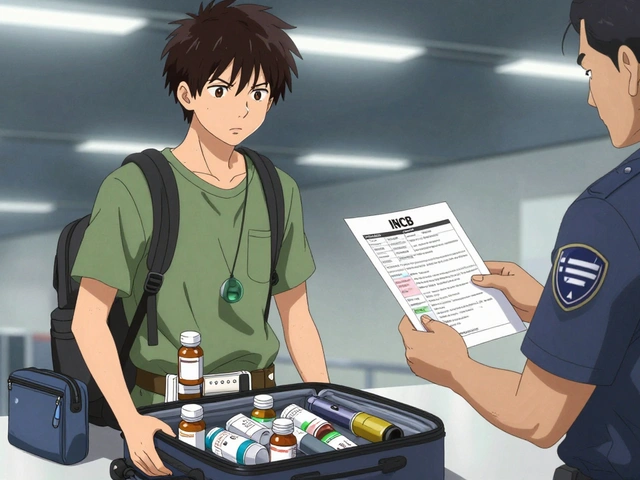
Fluoroquinolone Tendon Risk Calculator
Assess your personal risk of tendon rupture from fluoroquinolone antibiotics (ciprofloxacin, levofloxacin, moxifloxacin) based on key factors identified by medical research. This tool is not a medical diagnosis but helps you understand potential risks.
Risk Factors
Select all factors that apply to you:
Your Risk Assessment
For serious infections, these antibiotics may still be necessary. Always consult your healthcare provider.
Fluoroquinolones Can Cause Tendon Rupture - Even After You Stop Taking Them
If you’ve been prescribed ciprofloxacin, levofloxacin, or moxifloxacin for a sinus infection, urinary tract infection, or pneumonia, you might think you’re safe once the pills are finished. But here’s the truth: fluoroquinolones can damage your tendons - sometimes weeks after you’ve stopped taking them.
It’s not rare. In the UK alone, tens of thousands of people have experienced tendon pain or rupture linked to these antibiotics. The Achilles tendon, the thick cord behind your ankle, is the most vulnerable. In fact, nearly 90% of fluoroquinolone-related tendon injuries happen there. And it’s not just older adults - though they’re at highest risk. Even people in their 40s and 50s have suffered ruptures after taking these drugs for a simple chest infection.
Who’s Most at Risk?
The danger isn’t the same for everyone. Some people face a much higher chance of tendon damage. Here’s who needs to be extra careful:
- People over 60 - risk jumps dramatically after age 60, and skyrockets after 80
- Those taking corticosteroids - like prednisone - at the same time. This combo increases rupture risk by 46 times
- People with kidney problems - fluoroquinolones build up in the body if kidneys aren’t clearing them
- Diabetics - high blood sugar affects tendon health and healing
- Anyone who’s had a tendon injury before
One study tracked 6.4 million patients in the UK and found fluoroquinolone users were more than four times more likely to develop tendinitis and twice as likely to suffer a full rupture compared to those who didn’t take these antibiotics. Another study in Taiwan showed that people taking fluoroquinolones had a 42% higher chance of tendon problems than those who didn’t.
When Does the Damage Happen?
Many assume side effects show up right away. But fluoroquinolone-related tendon damage is sneaky.
The median time from starting the drug to first pain is just six days. But here’s what most people don’t know: symptoms can appear after you’ve finished the course. Up to half of all tendon injuries happen weeks or even months after stopping the antibiotic. That’s why so many patients are confused - they think they’re safe once the pills are gone.
One case in the medical literature described a patient who ruptured their Achilles tendon just two hours after taking their first dose. Another patient developed pain 11 days after finishing a 10-day course. There’s no safe window. If you feel any new tendon pain - especially in the heel, shoulder, or wrist - stop the medication and call your doctor immediately.

Why Do Fluoroquinolones Attack Tendons?
It’s not just an allergic reaction. These antibiotics directly damage tendon tissue at the cellular level.
Research shows fluoroquinolones trigger:
- Cell death in tendon cells (apoptosis)
- Release of harmful chemicals like nitric oxide that break down collagen
- Damage to mitochondria - the energy factories in your cells
- Disruption of magnesium and calcium signaling, which tendons need to stay strong
The Achilles tendon is especially vulnerable because it’s under constant stress, has poor blood supply, and contains high levels of collagen - the exact protein these drugs break down. That’s why it’s hit far more often than other tendons.
What Do Doctors Say Now?
Regulators around the world have taken action.
In 2008, the U.S. FDA added a black-box warning - the strongest possible alert - to fluoroquinolone labels. In 2019, the UK’s MHRA restricted their use even further: doctors can only prescribe them when no other antibiotic will work. The European Medicines Agency did the same in 2018.
Today, guidelines from the Infectious Diseases Society of America say fluoroquinolones should be a last resort - not a first choice - for common infections like bronchitis or sinusitis. They’re still used for serious threats like anthrax or complicated kidney infections. But for a simple UTI? There are safer options.

What Should You Do If You’re Prescribed Fluoroquinolones?
Don’t panic. But do ask these questions before filling the prescription:
- Is this infection serious enough to justify this drug? Could amoxicillin, nitrofurantoin, or trimethoprim work instead?
- Am I over 60? Do I take steroids? Do I have kidney disease or diabetes?
- Have I ever had tendon pain before?
If you’re already taking fluoroquinolones:
- Stop taking them immediately if you feel new pain, swelling, or stiffness in a tendon
- Don’t wait to see if it gets better - tendon rupture can happen suddenly
- Don’t resume the drug even if the pain goes away - the damage may already be done
- Rest the affected area. Avoid exercise, heavy lifting, or running
- See your doctor right away. An ultrasound or MRI can confirm if the tendon is damaged
And never, ever take fluoroquinolones with corticosteroids. That combination is a recipe for disaster.
What Happens After a Tendon Rupture?
A ruptured Achilles tendon is a major injury. It often requires surgery, months of physical therapy, and sometimes permanent weakness or limping. Some people never fully recover their mobility.
One study found that 50% of fluoroquinolone-related tendon ruptures are bilateral - meaning both tendons are affected. That’s rare with injuries from sports or trauma. This pattern is a red flag for drug-induced damage.
Recovery is slow. Even with surgery, many patients report ongoing pain, stiffness, and reduced strength a year later. And because the drug damages the tendon’s structure at a cellular level, healing is often incomplete.
Is There Any Good News?
Yes. Awareness is rising. More doctors are avoiding fluoroquinolones unless absolutely necessary. New research is looking at genetic markers that might predict who’s most at risk. Some scientists are even trying to redesign these antibiotics to remove the tendon-damaging side effects.
But until then, the safest choice is simple: avoid fluoroquinolones unless you have a life-threatening infection and no other option.
If you’ve had a tendon injury after taking ciprofloxacin, levofloxacin, or moxifloxacin, you’re not alone. Thousands have been affected. And if you’re currently on one of these drugs, pay attention to your body. Pain isn’t normal. It’s a warning.
Can fluoroquinolones cause tendon rupture even after I stop taking them?
Yes. While most tendon problems start within the first month of treatment, up to half of all cases occur after you’ve finished the course. Symptoms can appear days or even months later. This delayed onset makes it hard to connect the injury to the drug, which is why many patients don’t realize the cause until it’s too late.
Which fluoroquinolone has the highest risk of tendon damage?
Levofloxacin is linked to the most cases of tendon injury, followed by ciprofloxacin. Moxifloxacin carries a lower but still significant risk. All fluoroquinolones carry the same black-box warning from the FDA. No one is safe from this side effect.
Is tendon damage from fluoroquinolones reversible?
Mild tendinitis may improve with rest and stopping the drug. But once a tendon ruptures, full recovery is rare. Even with surgery and months of rehab, many people are left with chronic pain, reduced strength, and limited mobility. The damage to tendon cells and collagen structure is often permanent.
Why is the Achilles tendon most often affected?
The Achilles tendon has less blood flow than other tendons, making it harder to repair. It’s also under constant stress from walking and running. Fluoroquinolones weaken collagen - the main protein in tendons - and the Achilles, already vulnerable, breaks down first. Studies show it’s involved in nearly 90% of fluoroquinolone-related tendon injuries.
Should I avoid fluoroquinolones if I’m over 60?
Yes - unless you have a life-threatening infection like sepsis or anthrax. People over 60 are six times more likely to rupture a tendon on these drugs. Those over 80 face a 20-fold higher risk. Safer antibiotics are available for most common infections. Ask your doctor for alternatives.
Can I take fluoroquinolones if I’m on prednisone?
No. Taking fluoroquinolones with corticosteroids like prednisone increases your risk of tendon rupture by 46 times. This combination is extremely dangerous and should be avoided at all costs. If you need both medications, your doctor must find a different antibiotic.
Are there any alternatives to fluoroquinolones for a UTI or sinus infection?
Yes. For uncomplicated UTIs, nitrofurantoin or trimethoprim are first-line. For sinus infections, amoxicillin or doxycycline are preferred. Fluoroquinolones should only be used if these fail or if you’re allergic. Most doctors now avoid them for routine infections because of the risks.







10 Comments
And yes, the Achilles is ground zero. It's basically a rope made of collagen under constant tension. Fluoroquinolones don't just irritate it - they dissolve the glue holding it together.